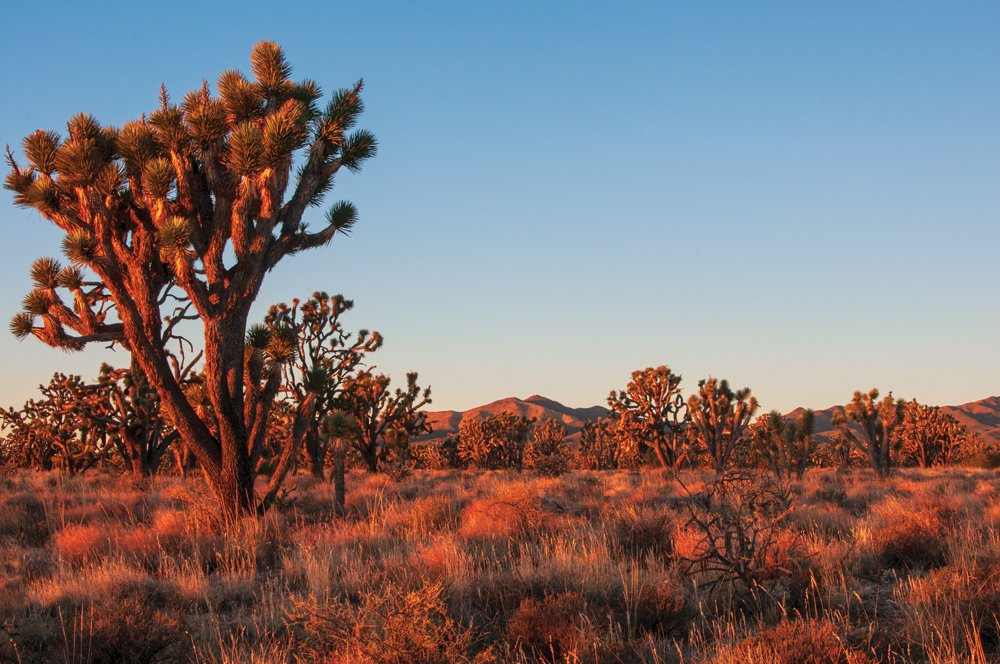Birding Among The Ancient Ones
Spring 2024
Wee Thump Joshua Tree Wilderness offers surprising avian variety all year long.
BY MORRIGAN DEVITO

Scaly Joshua trees sweep by in shades of brown, green, and gold on the route to the Wee Thump Joshua Tree Wilderness, now part of the 500,000-acre Avi Kwa Ame National Monument. Located west of Searchlight on State Highway 164, this hushed landscape gently slopes down from the base of the McCullough Range. At 6,050 acres, the wilderness provides critical habitat for many species of plants and animals, including more than 100 species of birds.
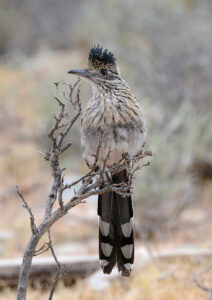
BIRDS OF THE WEE THUMP
It takes patience and sharp senses to meet the birds of the Wee Thump Wilderness, and you may find yourself waiting for the slightest hint of fluttering or the faintest chirp. Be advised: When waiting for birds, suddenly every leaf and branch looks bird shaped.
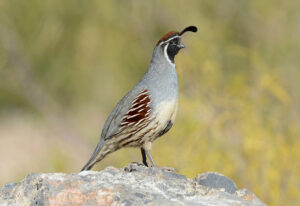
Though elusive, the birds are woven into the landscape. Wait long enough, and you’ll spot greater roadrunners and Gambel’s quail finding groundcover, cactus wrens nesting in Joshua trees, and red-tailed hawks and common ravens sailing over the mosaic of desert plants. Although some birds stay here year-round, many come and go seasonally on migratory routes, attuned with rhythms of light and temperature. To really get to know the birds here, visiting in different seasons will paint the fullest picture.
LOOKALIKES IN THE JOSHUA TREES
Because Joshua trees are the tallest plants in the Wee Thump, they are a great place to start looking for birds. In the wintertime, two lookalike woodpeckers make their home in the tree’s twisted limbs: the gilded flicker and the northern flicker.
Many birders come to the Wee Thump to see the gilded flicker, as this is the only place in Nevada where they have been recorded. With a swipe of red on their cheeks (for males) and speckled breasts that look like the grooves of Joshua tree bark, the two species look nearly identical. That is, until they fly away. The gilded flicker has underwings as gold as a sunrise, whereas the northern flicker has red underwings like a sunset.
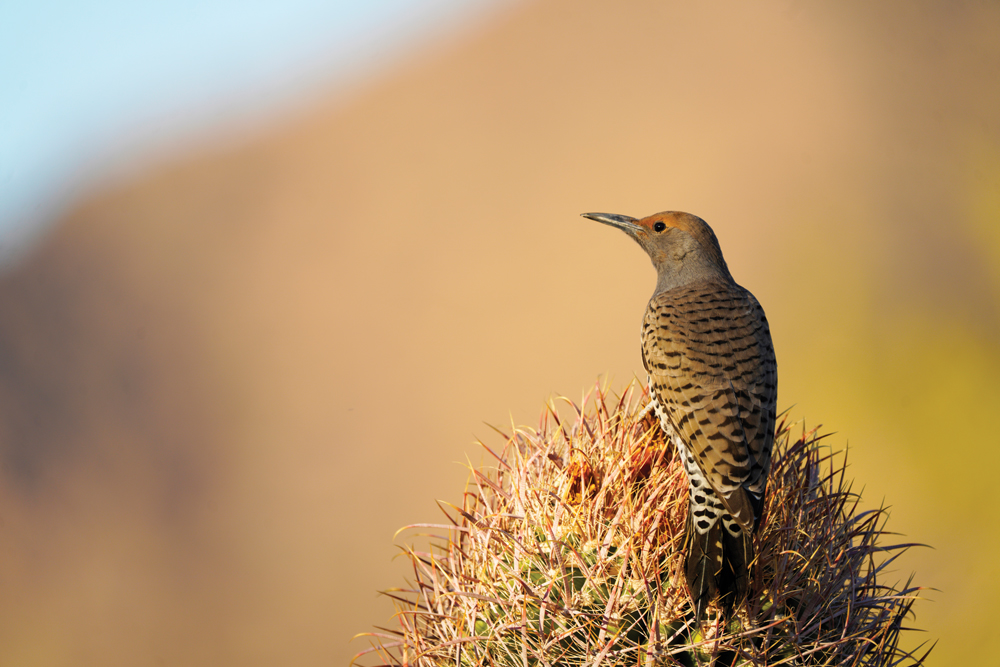
THRASHERS BENEATH THE THORNS
Don’t forget to look for birds and other wildlife on the ground when exploring the Wee Thump. Beneath thorny chollas, leafy creosote, and blackbrush, LeConte’s thrashers and Bendire’s thrashers forage for insects by swishing their bills back and forth.
What these birds have in common, besides being thrashers, is their secretiveness. Otherwise, they have different habitat preferences. When they arrive in late March for the breeding season, the golden-eyed Bendire’s thrasher can be found peering out across the desert from the Joshua trees in which they build their nests. In contrast, LeConte’s thrashers are year-round residents. Pale like the desert sand, they are more likely to be seen in desert washes at lower elevations and prefer to build nests in creosote habitats.
Both species are closely monitored by biologists because their numbers are dwindling due to drought and urbanization. Fortunately, the best action to help them is by protecting public lands. So, although these birds aren’t readily seen, they are very important to the story of the Wee Thump and the larger Avi Kwa Ame.
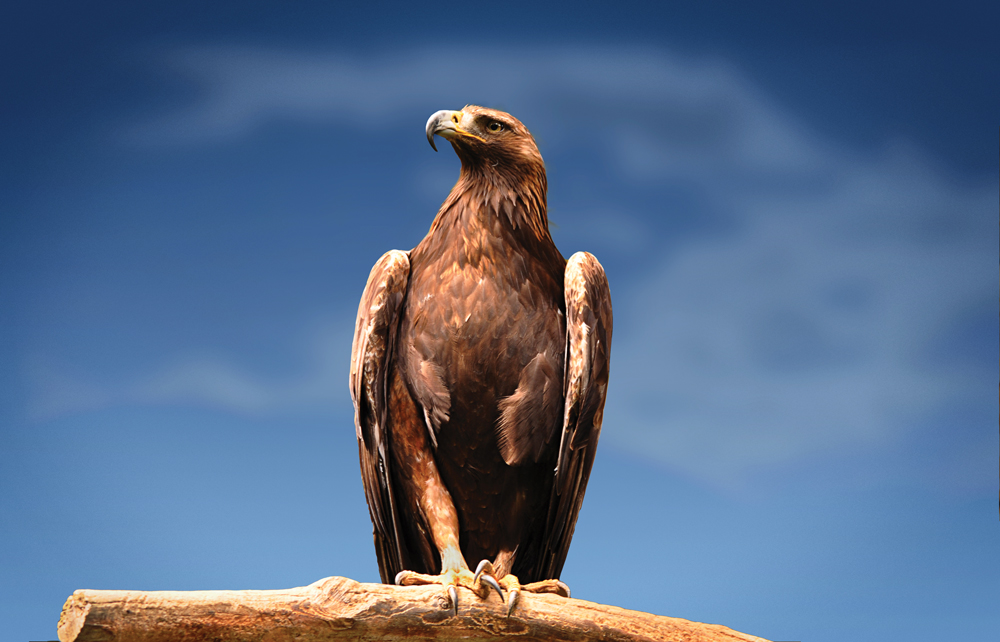
MAJESTIC HUNTERS
Golden eagles—one of the largest birds of prey in North America—can be spotted soaring over the Wee Thump Wilderness. Fossils dated in California indicate that these birds trace their lineage back to about 2.8 million years ago. Today, the golden eagles at Wee Thump are living as their ancestors did, scouring the desert for mammals like black-tailed jackrabbits and ground squirrels.
With a flight speed up to 80 mph and powerful talons that can clutch up to eight pounds, golden eagles will even hunt baby mule deer and bighorn sheep, sometimes knocking them off balance before they strike. Golden eagles live primarily in the McCullough Range, but they sometimes fly into the lowlands to hunt.
EXPLORE SAFELY
On your next journey to the Wee Thump Wilderness, keep your eyes open for these birds and their specialized habitats. And who knows, maybe you’ll see other animals such as bighorn sheep, desert tortoise, rattlesnakes, and more. Remember to give wildlife space, and leave no trace by picking up trash and staying on the established roads and trails.
There are no services in the Wee Thump Wilderness: The nearest facilities are in Searchlight. For the most updated maps and information about Wee Thump Wilderness, visit the Bureau of Land Management’s website.
ANCIENT ONES OF THE MOJAVE
To the Paiute who originally inhabited this landscape, Wee Thump means “ancient ones.” After spending time here, it’s hard not to see the silhouettes of the land’s first caretakers in the bends and curves of Joshua tree shadows. The trees only grow half an inch every year, a feat of survival given that some grow 30 feet tall despite the scant rainfall beneath the blazing sun.
The wilderness is home to two distinct plant communities, each with species whose ecological roots stretch far back into time. On the southeast side is the desert scrub, where creosote soak up the morning sun. Scattered between creosote are domed white bursage and thorny prickly pear cactus and cholla. Mojave yuccas—evolutionary cousins of the Joshua tree, both in the agave family—also poke through. Although they look similar, the Mojave yucca has longer leaves and curly fibers at the leaf edges.
At a higher elevation on the northwest side are the legendary Joshua trees, which live on a much different time scale than humans. About 2.6 million years ago, the giant ground sloth ate the Joshua tree’s seeds, helping them spread across the Mojave Desert. Today, these trees stand alongside buckhorn cholla, which poke through the soil like the fallen antlers of the mule deer that also roam the landscape. Blackbrush, another common plant in this area, becomes dormant in the summer and sheds its leaves, leaving spiny skeletons across the desert.
While you explore, greet the landscape with gratitude and an open mind. Look closely at the textures of the landscape: the smooth sky, the jagged edges of plants, the crumpled mountain ridges.
